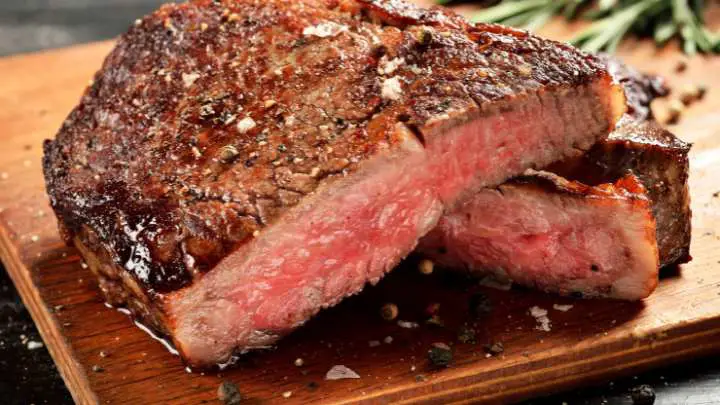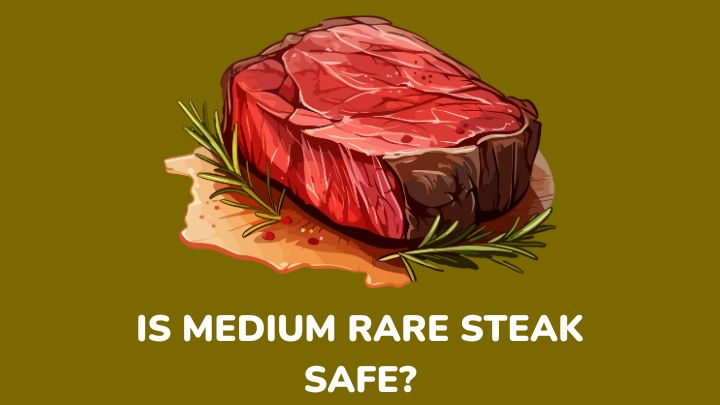If you take steak advice from the average steak aficionados, they’ll tell you medium rare is one of the best ways to enjoy your steak. It is indeed true because at this level of doneness, the steak is juicy, and all its rich flavors are still intact.
However, the appearance of your steak may have you wondering if it is safe to eat it. Medium rare steak tends to look undercooked because of its red center and fleshy texture.
Surprisingly, the demand for this steak is on the rise in many steakhouses and even homemade recipes.
This article on the safety of medium rare steak will help you make your decision on the level of doneness of your steak.
What is medium rare steak?

Medium rare steak is seared to give it a flavourful crust and a pink or red interior. It is tender, juicy, and succulent, and retains its natural meat flavors. Its rich buttery flavor and melt-in-your-mouth mouthfeel are what make it highly preferred by many.
Is medium rare steak safe?
Medium-rare steak is safe to eat. Most chefs and steak connoisseurs say this is the best level of doneness for steak. It may look undercooked, but it is not.
Naturally, bacteria present in meat are found on the surface. The cooking temperature is enough to destroy these bacteria and make it safe for consumption. In the right conditions and with proper handling, the steak is safe to eat.
However, following the recommendation from the United States Department of Agriculture (USDA) and Centers for Disease Control and Prevention (CDC), all steaks should be cooked to an internal temperature of at least 145°F(63°C).
The cooking temperature for medium rare steak falls below this, and it is believed that the steak may still contain some disease-causing bacteria. If consumed, there is a high risk of food poisoning and other life-threatening consequences.
What temperature is medium rare steak?
Medium rare steak is cooked to an internal temperature of 130 to 135°F (55 to 57°C). This temperature is below the USDA recommendation and is considered undercooked by this board. But most chefs and steak experts say otherwise.
To check the temperature of your steak, probe the center with a meat thermometer and read the temperature.
How long do you cook steak to medium rare?
Cook a 1-inch steak to medium rare for 4 minutes on each side until it reaches an internal temperature of 130 to 135°F (55 to 57°C).
After cooking, leave the steak to rest for two to five minutes to allow the juices to circulate and not leak out. Leaving steak to rest also makes it tender, unlike steak that is cut open immediately after cooking.
Is medium-rare steak safe for toddlers?
Medium-rare steak is considered undercooked and may not be safe for toddlers. Toddlers have a more underdeveloped digestive and immune system than adults. This makes them more susceptible to foodborne illnesses.
Moreover, it is not advisable to give steaks to toddlers because they can be hard to chew and could be a potential choking hazard. If you want to give your toddler steak, go for a higher level of doneness like medium, medium-well, or well-done.
Is medium-rare steak safe for pregnant women?
Medium rare steak is not 100% safe for pregnancy. It is very likely that the steak still contains bacteria that can harm the baby’s health. Harmful bacteria like E. coli and Salmonella may survive in the meat.
Also, parasites like toxoplasma may be present in the steak. Toxoplasma infection can cause toxoplasmosis, which can affect fetal growth.
Are there any benefits of eating medium-rare steak?
Yes, there are. Medium rare steak contains more of the omega-3 fatty acids present in grass-fed beef. These fatty acids help to lower cholesterol levels, prevent blood clots, fight off autoimmune diseases, reduce inflammation, and improve mental health.
There are also claims that medium rare steak contains more conjugated linoleic acid, which helps to prevent certain types of cancer.
Many chefs also say that medium rare steak contains more iron and phosphorus, which increases oxygen levels in the blood and strengthens the bones.
FAQs
Should there be blood in medium-rare steak?
There shouldn’t be blood in medium-rare steak if you are sure you washed and drained it properly. If you cut into your steak and see a red liquid, that is myoglobin, not blood. Myoglobin is the protein responsible for the red color in meats.
Is medium-rare steak safer than well-done steak?
If you are talking about contamination, both levels of doneness do not contain bacteria. The difference between them is the moisture content, texture, and flavor.
Medium-rare steak has more moisture and is softer than well-done steak. Also, it is the most recommended level of doneness for steak.
What is the best level of doneness for steak?
The best level of doneness varies with personal preferences. If you prefer your steak tender and juicy, it will be medium rare or rare. If you prefer it chewy and fully cooked, you can cook your steak to medium or well-done.
Conclusion
Food taste and food safety should go hand in hand. It’s not a lie that medium rare steak is one of the best steak options you can have.
Also, it doesn’t pose any risk to your health. While cooked meat is a high-risk food, you are a good deal safer with medium-rare steak.
Medium rare steak is not raw. The cooking time and temperature are enough to destroy the bacteria that cause food poisoning. However, medium rare chicken or turkey are not recommended because there is a higher risk of food poisoning with them.
In addition, read about medium rare plus steak – cooking temperature, cooking time, and everything in between.
Thanks for reading.
